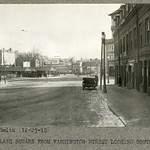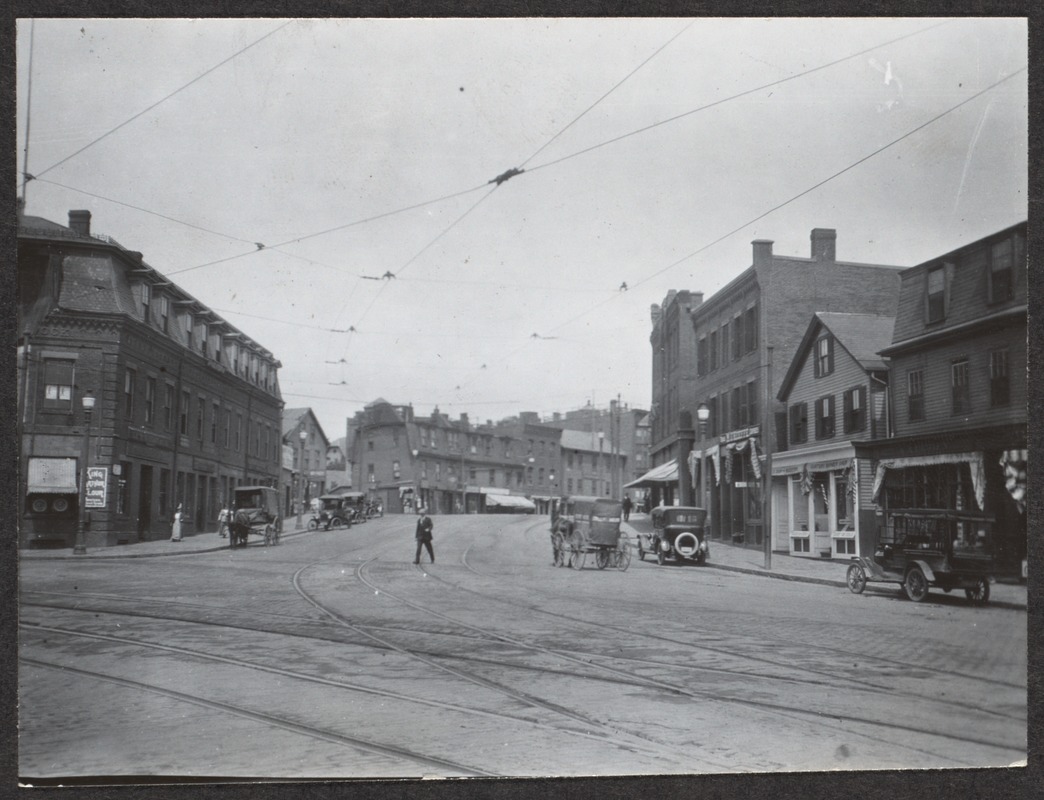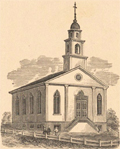|
The Society
Historical Information
Photo & Map Collections
Exploring Brookline
Links
Program Archives
|
Photo Collection
 |
Brookline Village, 1937
Looking east on lower Washington St. toward Boston. Walnut St. on the right. Note scaffolding for the construction of the Brookline Theater on the left side of the street. All the buildings were raised in the 1960s as part of a large urban redevelopment program. Photo taken on 11/29/1937 by C. Parker, Brookline Engineering Dept.
|
 |
Brookline Village, December 23, 1915
Washington St. looking south. Start of Boylston St. background right. Guild building, foreground right. Only the fire station, partial view, remains.
[Source: Olmsted]
|
 |
Burns Pharmacy, 127 Washington St., Brookline Village
Thomas Edwards Burns opened his pharmacy at 127 Washington St. circa 1906 and remained there until the business was taken over in early 1942, before becoming Hughes Drug. Co. by that October.
[Source: Joel Shield]
|
 |
Brookline Village: Chestnut Hill Trolley (Boylston St. - Ipswich St. - Brookline Ave.)
|
 |
Brookline Village, Guild Block Building, circa 1903
Boylston St. looking west to the left; Washington St. on the right. Pictured from left to right:
[#164 Washington St.] On the corner of the Guild Block building, the faded sign of the previous owner of the grocery store, Francis H. Bacon, is still visible to the right. Thomas F. McMahon, who had been a clerk in Bacon’s store, took over the business when Bacon died in 1898.
[#172 Washington St.] Henderson Dairy and T. A. Conroy, Gas and Electric Fixtures.
[#174 Washington St.] Horace James, Mason
[#176 Washington St.] George P. Johnson Fish Co.
[#178 Washington St.] W. H. Pazolt, Sign and Carriage Painting; and F. H. McMahan, Plumber
|
 |
Guild Block, Brookline Village
Lower Washington St. looking west. This is probably circa 1911 but an exact year is difficult to determine. The date spans of the visible businesses:
- #164 (aka 166) Washington St. (corner of the Guild Building), first floor: Thomas H. McMahon, Grocer. In 1898, he took over the existing business in which he had been a clerk and maintained it until 1919 when the building was sold to and replaced by the Brookline Bank.
- #166 Washington St.: The Brookline Print. Visible on the upper left of the building are the names of Wallace B. Conant and Carl A. Smith. Smith joined Conant’s business in 1909 and is no longer listed with the business after 1911.
- #166 Washington St.: Forster Bros., Upholsterers. Visible on the far upper left of the building is the sign for “Upholsterers”. The brothers were there from 1908 - 1917
- #21 Boylston St.: John H. Shea, Horse shoer, maintained his business there until 1913. In a 1909 photo there was a large sign hanging out front which is no longer visible.
[Source: Brookline Preservation Department]
|
 |
Village Square, December 12, 1934
[Source: Leo Sullivan]
|
 |
Brookline Village, circa 1875
This is the oldest known photograph of the Village which includes the “Guild Block”. On the corner is J. Anson Guild’s grocery store which was a Village fixture for many years. On the right side of the building are a number of small businesses: wheelwright, fish market, barber, plumber. The top floor was called “Goddard Hall” and was used for dances and meetings.
Only one side of Washington St. has a bridge over the railroad tracks. The small road to the right is essentially another lane of Washington St. with additional access under the bridge to White Place. In ten years, the bridge would extend across both lanes and the entrance to White Place would be raised to that level.
[Source: Brookline Public Library]
|
 |
Brookline Village, Washington St.
Looking north on Washington St. Only one side of Washington St. has a bridge over the railroad tracks. The small road to the right is essentially another lane of Washington St. with additional access under the bridge to White Place. In 1888, the bridge would be extended across both lanes.
|
 |
Brookline Village
Washington St. looking north.
[Source: Digital Commonwealth]
|
 |
Brookline Village, circa 1910
Washington St., looking south at the Village Square
- [173 Washington St.] a partial view of the building
- [167/163 Washington St.] Edward J. Cameron, shoemaker (left) and Michael O'Keeffe, grocer (right)
- Trolley stand
- [Corner, Morss Ave. & Walnut St.] The large taxi billboard is sitting on top of the Brookline Riding School building at 2 Walnut St. Morss Ave is to the left. The building had been the barn housing the horse-drawn cars for the Metropolitan Railway Co.
- [6 Walnut St.] Macleod Bros. Furniture and Piano Moving
- [22 Walnut St.] immediately to the right of the “Renting an Automobile” sign is the store of Nils Lilja, Painting and Decorating
- [140 Washington St.] New fire station completed in 1908 and still in use today
- [#164 Washington St.] Thomas H. McMahon, grocer, on the corner of the Guild Block building, sign visible
- [#166 Washington St.] Forster Bros., Upholsterers, upstairs in the Guild Block building, sign visible
- [#166 Washington St.] T. A. Conroy, Gas and Electric Fixtures, upstairs in the Guild Block building, sign visible
[Source: Joel Shield]
|
 |
Brookline Village, Looking North on Washington St., 1865
This is one of the two earliest known photos of the Harvard Sq. area of Brookline Village. The business life of the Village was still largely centered along Lower Washington St. From left to right:
- Carriage in front of Kenrick Brothers, stoves and furnaces
- Carriage in front of Marshall Russell, Grocer [unconfirmed]
- Large tree in front of the house of Benjamin Davis
- "Panter’s Building" at the apex of Washington and Harvard streets. In 1859, John Panter acquired the former Baptist Church building, moved it forward into the apex of the two main thoroughfares, and created storefronts on the first floor.
- Behind the "Panter’s Building" is the steeple of the newer Baptist Church on Harvard St.
- Coming forward right from the church is the "Rooney Building" which was later raised up one story to accommodate stores underneath and is still standing.
- Foreground right is the train station. This was also the location of the telegraph office (sign visible) and the post office (washed out sign above)
|
 |
The Original Baptist Church
Erected in 1828 in Harvard Square. In 1858, the church moved to a new structure at the corner of Harvard St. and Pierce St. In 1859, John Panter acquired the former structure and moved it forward into the apex of the two main thoroughfares, Washington St. and Harvard St., and created storefronts on the first floor.
The church was the outgrowth of meetings first organized by Elijah Corey who sought an alternative to the First Parish Church which was located at the top of Walnut surrounded by the monied elite of Brookline to whom the parish appealed.
[Source: Digital Commonwealth]
|
 |
Brookline Village, Looking North on Washington St., circa 1865
This is one of the two earliest known photos of the Harvard Sq. area of Brookline Village. The business life of the Village was still largely centered along Lower Washington St. From left to right:
- Carriage in front of Kenrick Brothers, stoves and furnaces
- Carriage in front of Marshall Russell, Grocer [unconfirmed]
- Large tree in front of the house of Benjamin Davis
- "Panter’s Building" at the apex of Washington and Harvard streets. In 1859, John Panter acquired the former Baptist Church building, moved it forward into the apex of the two main thoroughfares, and created storefronts on the first floor.
- Behind the "Panter’s Building" is the steeple of the newer Baptist Church on Harvard St.
- Coming forward from the church is the "Rooney Building" which was later raised up one story to accommodate stores underneath and is still standing.
- Foreground right is the train station. This was also the location of the telegraph office (sign visible) and the post office (washed out sign above)
|
 |
St. Mary's Church of the Assumption, circa 1873
The Church was built in the early 1850s between Andem Place and Station Street to serve the growing Catholic, mostly Irish, population of Brookline. The first service was held on Christmas day, 1853. The current church on Linden Place was opened in 1886 and this building was later incorporated into the Holtzer Cabot factory on Station St.
The photo is one of a series of stereoviews taken circa 1873-1876 by Richard Hills and son. There is a bit of an optical illusion in the left foreground. Shown is the wooden fence from the property on the other side of Andem Place.
[Source: Digital Commonwealth]
|
 |
Andem Place
Looking south towards Brookline Village. To the right is the rear of the Colonnade buildings. In the background, on the left, is the only known side view of 171-173 Washington St. (at the rear of today’s 10 Brookline Place). In contrast to the ordinary front, the side of the building is embellished along the roof line and with accent pillars down the sides. The large window signs can’t be read but it can be speculated that these features were viewed by the passengers on the railroad that passed right next to the building.
[Source: Digital Commonwealth]
|
 |
Brookline Village, circa 1876
Looking south on Washington St. The third Colonnade building is seen on the left it its original position, lower than the second Colonnade building. It can be seen today higher than the second building having been raised to accommodate the widening of the bridge in 1886. In the center rear of the photo, the individual signs for the stores in the Guild Block can be seen. Prominently displayed on the end of the building is the oval sign for F. Sullivan, Plumber. To the right of that is the house known as the “old Webber house” which had two stories or more of basement below the level of the bridge where it abutted the railroad tracks.
[Source: Brookline Public Library]
|
 |
Brookline Village, 1885
Washington St. looking south toward the fire station, in the distance, on lower Washington St.; Station St. is to the left; Guild Block building is visible in the rear center.
|
 |
Brookline Village, Station St.
Looking north on Washington St.; brick building in foreground exists today. The building was raised significantly to match the height of the bridge before Station St. was added.
|
 |
Brookline Village Train Station, circa 1885
At Station St., looking west under the Washington St. bridge. Only entrance to White Place.
Tom Condon, Sr. Civil Engineer for Brookline writes:
It would be interesting to note that the roadway passing under the bridge to the right of the railroad was the only access to White Place at the time since it was a dead end street. When the bridge was later widened, it was also shortened so as to only cross the railroad tracks. The end of White Place was filled in to meet the grade of the new bridge. That is the reason for the retaining wall between White Place and the "D" line which is located about where the center support of the bridge is.
|
|